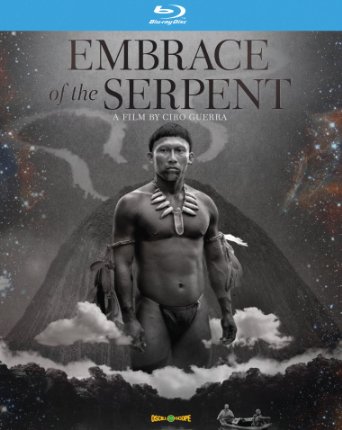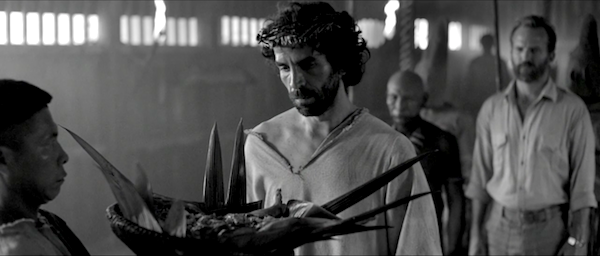The Furniture: The Venomous and Fanatical 'Embrace of the Serpent'
 Monday, June 27, 2016 at 10:31AM
Monday, June 27, 2016 at 10:31AM
 "The Furniture" is our weekly series on Production Design. Here's Daniel Walber...
"The Furniture" is our weekly series on Production Design. Here's Daniel Walber...
Embrace of the Serpent, Colombia’s first-ever nominee for Best Foreign Language Film, contains multitudes. Ciro Guerra filters the Amazon Basin into a tremendous cinematic document, a rich cornucopia of unexpected tableaux. The choice to confine this colorful landscape to black and white would be uncanny enough on its own, but the narrative is also unmoored by transitions between the two timelines. Long before the final hallucination, our perceptions are overwhelmed by the range of complex images.
And, of course, the work of production designer Angelica Perea, art director Ramses Benjumea and set decorator Alejandro Franco is an essential component. The best example of their work comes right at the film’s midpoint, with a pair of profoundly unsettling episodes that interrogate the role of Catholic missionaries in Colombia’s colonial history. [More...]
They come chronologically, beginning with a visit by Theo (Jan Bijvoet), Manduca (Yauenku Miguel) and the young Karamakate (Nilbio Torrest) to a remote mission. It is heralded by a sign that calls out to the “Temerosos de Dios,” the “God-fearing,” and an arch on the edge of the trees. Children emerge, all in white. This is a place of regimented faith.


It is also immediately apparent that something is wrong. The boys lead their guests past an unremarked-upon but unmistakable pair of stocks that hang at roughly the height of a child.
As it turns out, there is only one monk left. His colleagues ventured out to look for more pupils, but have not returned for two years. He sees their task as a heroic act of religious salvation, endorsed by the President of Colombia in the form of a plaque that hangs on the wall. Dated 1907, it lionizes the monks and praises them for “bringing civilization to the land of cannibals and savages.”

Manduca and Karamakate know that this grand endeavor also involves kidnapping and violent indoctrination, though they also know that they need the cleric’s hospitality. They cautiously eat their dinner in the darkened hall, haunted by candles and harshly arranged in the straight lines of the cross.
An altercation and an act of resistance send the scientific expedition off again to the river. However, a stunning spiral transition across the black water sends us right back to the entrance, this time with Evan (Brionne Davis) and the older Karamakate (Antonio Bolivar). In the intervening years, a strange new fanaticism has taken hold. The horrific human crucifixes that hover above the swamp make that eminently clear.


The scene at the mission, now under the control of a crazed messianic cult leader, is pretty surreal. This is no perversion born from a return to indigenous ritual, however. It seems clear that this fermented social collapse has emerged entirely from the excesses of brutal missionary Catholicism. The Christ figure, complete with a crown of thorns, reigns from a decorated throne within.
This point is subtly underlined by the production design, as well. Look at the walls. Formerly clean and unmarked, now they sport almost unrecognizable symbols of Christianity: fish.

This messiah is especially fascinated by transubstantiation, an article of faith that the young Karamakate emphasized in the earlier sequence as particularly strange. How can a religion that encourages the physical consumption of its god turn to a righteous crusade against the trumped up ghost of cannibalism in the forest? The whole second episode is gripped by food, drink, and the insane froth of rabid belief.
Yet in this case it is imprecision that drives the point home, unidentifiable liquids and solids that are further obscured by the black and white palette. The clerical abuse of the past is not a temporary confusion on the road to civilization, but rather an original sin that leads to the ingestion of poison, entrails and death. As the frenzy reaches its cannibalistic climax, nothing is lucid but the immense calamity that history has wrought.

previously on 'The Furniture' | More on Embrace of The Serpent




Reader Comments (2)
I was so glad when Jason included this one in the "scariest scenes of 2015" because yikes. This passage in the movie is so disturbing. That it's not the only hugely memorable thing or even necessarily the most memorable thing iis a testament to the movie which SO deserved that nomination.
transubstantiation gives me the heebie jeebies
Loved that you wrote about this for the series! Part of what makes the film so palpably real is the production design and especially how the school changes visually between the storylines.